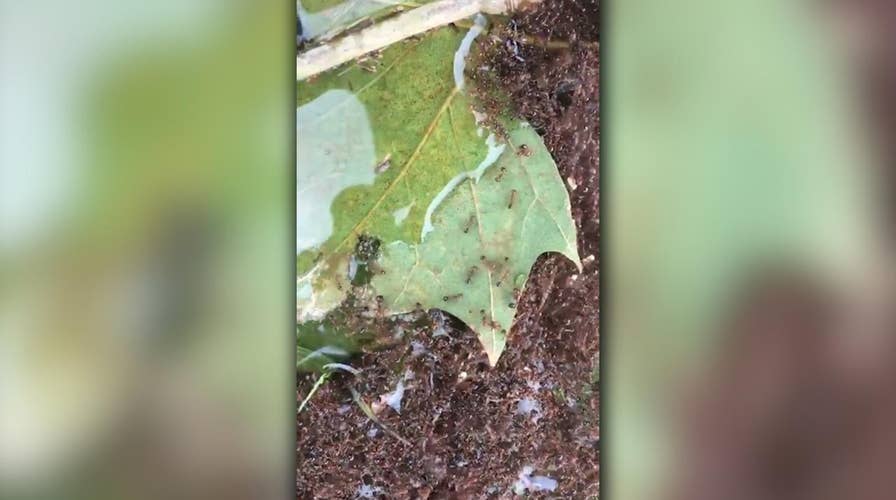Fire ants create floating rafts to survive Florence floods
Raw video: Kingston Police Department in North Carolina share footage of thousands of insects bunched together to create raft on top of post-Hurricane Florence floodwaters to protect queen.
Residents affected by the aftermath of Hurricane Florence may have noticed something unusual floating in the storm’s floodwaters: “islands” of fire ants.
"Fire ant colonies construct their nests in the soil. Sometimes these nests can grow to be 3-4 feet deep. Flooding after a storm event, like Florence in The Carolinas, will saturate the soil and push the ants up and out of their nest," Adrian Allen Smith, a research biologist and head of the Evolutionary Biology & Behavior Lab at the North Carolina Museum of Natural Sciences, told Fox News in an email Wednesday.
"So, when they are displaced from their nest, they cluster together and form a living raft. Workers cling to each other and provide their nest mates ground to stand on," he continued.
The ants will "float like this until they drift into dry land or the flood recedes and they can dig into the soil and rebuild their nest," Smith said, noting to The Charlottesville Observer the ants will "float indefinitely" if no dry land is found. "That’s when you get reports of people bumping into them."
Fire ants, much like other creatures, such as snakes, can be displaced from their habitats during hurricanes or heavy rainfall that results in flooding.
As for colonies of fire ants, the creatures will “form a loose ball, float, and flow with the water until they reach a dry area or object they can crawl up on. Floating fire ant colonies can look like ribbons, streamers, mats, rafts, or an actual 'ball' of ants floating on the water,” Texas A&M University Agrilife Extension specialist Paul Nester said.
SOUTH TEXAS RESIDENTS SEE INCREASE IN MOSQUITOES, SOME REPORTEDLY QUARTER-SIZED
“These amoeba-like ant masses contain all of the colonies’ members: brood (eggs, larvae, pupae), queen ants, winged reproductive males and females, and worker ants,” he continued.
While the ants work to survive, the insects can prove to be dangerous to humans who cross their path.
According to Smith, rafting fire ants are "in a state where their entire colony is unprotected and vulnerable to would-be predators" when they're displaced and floating to find a new area to call home. This can result in the ants producing more venom, he said, adding the insects have been known to deliver multiple stings if humans come into contact with them.
"Fire ants are notorious for their painful stings. A floating fire ant colony is 10s to 100s of thousands of stinging ants out in the open. Unlike honeybees, an individual fire ant is able to deliver multiple stings," Smith said.
“Avoid contact with floating mats of fire ants. If you are in a row boat, do not touch the ants with the oars since they can 'climb aboard' via the oars. Occasionally, floating ant masses are encountered even indoors in flooded structures,” Nester advised in the handout.
Fire ant stings can be treated by washing the affected area with soap and water, or using over-the-counter anti-itch or pain relieving creams, according to Healthline. Those allergic to fire ant stings could have a serious reaction if stung. Signs of a potentially life-threatening allergic reaction include nausea, dizziness and difficulty breathing, the publication warns.
North Carolina residents still dealing with the aftermath of Florence should wear protective clothing — such as “boots gloves, long pants, long-sleeve shirts, and socks. Spray insect repellent containing DEET onto your shoes and lower pants legs,” Nester recommended.
OHIO'S 'BEE MAN' REMOVES MASSIVE HORNETS' NEST FROM CAR IN SHOCKING VIDEO
Spraying fire ants with a mixture of water and biodegradable liquid dishwashing detergent has been known to sink the ants as well, according to Nester.
After Hurricane Harvey, Texas residents also saw an influx of floating fire ants.





















